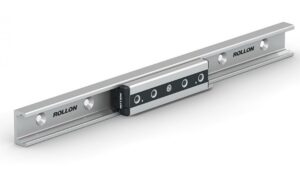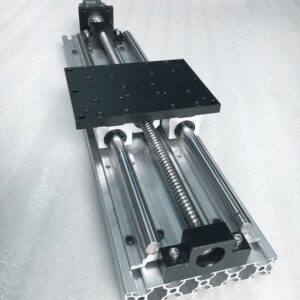Outline for Long-Form Article: Linear Motion Guides
| Main Heading | Sub-Headings |
|---|---|
| Introduction to Linear Motion Guides | Why precision motion matters, Overview of guide systems |
| What are Linear Motion Guides? | Definition, Primary function, Difference from plain bearings |
| History of Linear Motion Guides | Early motion systems, Evolution with modern industries |
| Key Components of Linear Motion Guides | Rails, Carriage, Rolling elements, Seals, End caps |
| Types of Linear Motion Guides | Ball-type guides, Roller-type guides, Miniature guides, Flanged guides |
| Materials Used in Linear Motion Guides | Stainless steel, Alloy steel, Protective coatings |
| Working Principle of Linear Motion Guides | Rolling vs sliding, Load distribution |
| Advantages of Linear Motion Guides | Accuracy, Durability, Load-bearing capacity, Efficiency |
| Disadvantages and Limitations | Cost, Maintenance, Misalignment issues |
| Applications of Linear Motion Guides in Industry | CNC machines, Robotics, Medical devices, Automotive, Aerospace |
| Comparison with Other Linear Systems | Bushings, Shafts, Ball bearings |
| Load Capacity and Performance | Static loads, Dynamic loads, Moment loads |
| Accuracy and Precision | Positioning, Repeatability, Straightness of motion |
| Maintenance of Linear Motion Guides | Lubrication, Cleaning, Inspection |
| Common Problems and Troubleshooting | Wear, Noise, Misalignment, Contamination |
| Installation of Linear Motion Guides | Proper mounting, Alignment process |
| Innovations in Linear Motion Guides | Smart sensors, Coatings, Lightweight materials |
| Cost Considerations | Pricing factors, Long-term investment |
| Choosing the Right Linear Motion Guides | Based on load, environment, and application |
| Future of Linear Motion Guides in Industry 4.0 | Digital monitoring, Predictive maintenance |
| Environmental Impact and Sustainability | Eco-friendly lubricants, Recycling materials |
| Top Global Manufacturers | Leading brands, New industry players |
| Case Studies of Linear Motion Guides | Aerospace, Semiconductor, Packaging |
| Conclusion | Final insights |
| FAQs about Linear Motion Guides | Six common questions with answers |
Introduction to Linear Motion Guides
In today’s world of precision engineering, linear motion guides are indispensable. They provide stable, smooth, and highly accurate motion in one direction, making them essential for industries that rely on repeatability and efficiency. Whether it’s a CNC machine cutting metal with micrometer precision or a robotic arm assembling delicate components, linear motion guides ensure everything runs smoothly.
The global rise of automation and Industry 4.0 has only increased the demand for these systems. They are no longer optional add-ons but critical components in high-speed, high-precision environments where failure or inaccuracies can result in costly downtime.
What are Linear Motion Guides?
A linear motion guide is a mechanical system designed to provide precise and smooth linear movement along a fixed path. Unlike plain bearings, which slide and generate significant friction, linear motion guides rely on rolling elements like balls or rollers that circulate inside the carriage. This design drastically reduces friction and allows for higher accuracy, durability, and efficiency.
The primary purpose of linear motion guides is to support loads and guide movement with minimal resistance. They are especially valuable in applications where motion must remain accurate and repeatable under high loads and speeds.
History of Linear Motion Guides
Linear motion systems have a long history. Ancient builders used lubricated sliding stones and rollers to move massive objects. However, these early systems lacked precision and reliability.
The turning point came during the Industrial Revolution. Advances in metallurgy and machining enabled engineers to design more refined sliding systems. Eventually, the introduction of recirculating ball bearings in the mid-20th century revolutionized linear motion, laying the foundation for today’s high-precision linear motion guides.
Modern innovations have added coatings, advanced materials, and sensor integration, turning linear guides into intelligent systems capable of monitoring their own performance.
Key Components of Linear Motion Guides
Linear motion guides may appear simple, but they are carefully engineered assemblies. The main components include:
Guide Rails: Precision-ground steel rails that provide the linear path.
Carriage (or Block): The moving component that slides along the rail.
Rolling Elements: Steel balls or rollers that circulate inside the carriage to minimize friction.
Seals: Protect the interior from contaminants while retaining lubrication.
End Caps: Guide rolling elements back into circulation smoothly.
Each part must be manufactured to strict tolerances, as even the slightest imperfection can affect accuracy and service life.
Types of Linear Motion Guides
There are several types of linear motion guides, each suited for specific applications:
Ball-Type Guides: The most common, using steel balls for smooth, precise movement.
Roller-Type Guides: Use cylindrical rollers, offering higher rigidity and load capacity.
Miniature Guides: Compact, lightweight versions used in electronics, optics, and medical equipment.
Flanged Guides: Provide easier mounting and higher stability, often used in heavy-duty machinery.
The choice depends on the balance between precision, load requirements, available space, and cost.
Materials Used in Linear Motion Guides
The performance and durability of linear motion guides rely heavily on the materials used in their construction. Engineers select materials based on load requirements, operating environment, and expected lifespan.
Stainless Steel: Highly resistant to corrosion, making it ideal for food processing, cleanrooms, and medical equipment.
Alloy Steel: Provides superior strength and fatigue resistance, best suited for heavy-duty industrial machinery.
Ceramic Coatings: Reduce friction, resist corrosion, and extend lifespan in high-precision industries such as semiconductor manufacturing.
Surface Treatments: Black oxide, chrome plating, and nickel coatings enhance resistance against rust, dust, and environmental damage.
Material selection plays a decisive role. For example, stainless steel ensures hygiene and rust resistance in medical devices, while alloy steel ensures rigidity in high-load applications like aerospace assembly.
Working Principle of Linear Motion Guides
The efficiency of linear motion guides lies in their reliance on rolling friction rather than sliding friction. Inside the carriage, rolling elements (balls or rollers) circulate continuously.
The principle is simple:
As the carriage moves, rolling elements at the contact surface bear the load.
These elements roll through the load zone, minimizing friction and energy loss.
Once past the load zone, they are guided back through recirculation channels, ready to repeat the cycle.
This design ensures:
Smooth motion with minimal resistance.
Even load distribution, preventing localized wear.
High durability, as rolling elements experience less stress compared to sliding contact.
The result is precise, stable, and reliable linear motion, even under heavy loads and at high speeds.
Advantages of Linear Motion Guides
The popularity of linear motion guides across industries stems from their many advantages:
Exceptional Precision: Capable of micrometer-level positioning accuracy.
Durability: Engineered to last years under demanding industrial conditions.
High Load Capacity: Able to withstand significant static and dynamic loads.
Low Noise: Rolling elements ensure quieter operation compared to sliding systems.
Smooth and Fast Motion: Supports high-speed operations without vibration.
Reduced Maintenance: With proper lubrication and sealing, they require minimal upkeep.
These qualities make linear motion guides indispensable in fields like robotics, aerospace, and semiconductor manufacturing, where precision and reliability are non-negotiable.
Disadvantages and Limitations
Despite their strengths, linear motion guides have certain drawbacks:
Cost: They are more expensive than simpler linear bushings or shafts.
Installation Sensitivity: Precise alignment is crucial; misalignment can lead to uneven wear.
Environmental Vulnerability: Dust, dirt, and moisture can affect rolling elements if seals fail.
Overengineering for Small Tasks: For simple, low-precision applications, they may not be cost-effective.
Understanding these limitations allows engineers to weigh the trade-offs and deploy linear motion guides only where their benefits outweigh the costs.
Applications of Linear Motion Guides in Industry
Linear motion guides are at the heart of countless machines and systems:
CNC Machines: Enable tool heads and workpieces to move with extreme accuracy.
Robotics: Provide stability and repeatability in robotic arms and assembly systems.
Medical Devices: Found in imaging systems, surgical robots, and lab automation equipment.
Automotive Industry: Used in assembly lines, testing equipment, and parts manufacturing.
Aerospace: Support precise component assembly and testing processes.
Packaging and Printing: Ensure accurate, repetitive, and high-speed movements.
Their versatility across heavy-duty and delicate applications underscores their importance in precision engineering.
Comparison with Other Linear Systems
To appreciate the value of linear motion guides, it’s useful to compare them with other linear systems:
Bushings and Shafts: Cheaper and simpler but prone to friction, wear, and lower accuracy.
Plain Bearings: Easy to use but lack the precision and load capacity of linear guides.
Ball Screws: Provide both motion and power transmission, but cannot replace linear guides for multi-directional load-bearing.
Linear motion guides consistently outperform alternatives when high precision, durability, and load capacity are required.




